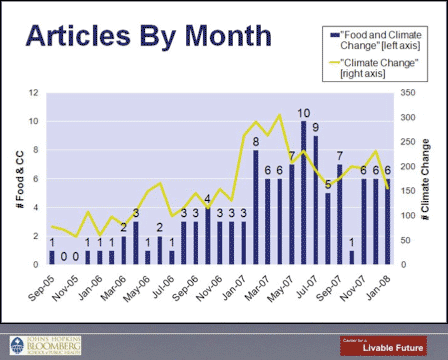
In 2006, the U.N. Food and Agriculture Organization published a 390-page report called “Livestock’s Long Shadow.” The dense document came to a startling conclusion: Livestock production — including land-use changes for pasture and crop production — contributes more to global warming than every single car, train, and plane on the planet.
Rajendra Pachauri, chair of the U.N. Intergovernmental Panel on Climate Change, recently reiterated this point. He called eating less meat “clearly the most attractive opportunity” to quickly reduce greenhouse-gas emissions. “Give up meat for one day [a week] initially, and decrease it from there,” he urged.

Roni Neff.
Photo: Roni Neff
So move over, Hummer; say hello to the hamburger as climate villain. And still, meat represents only part of the food industry’s vast ecological footprint.
If experts are increasingly focusing on food as a climate culprit, the media remain largely oblivious. When most of us think about the climate-change bad guys, we focus on Shell and ExxonMobil — and let industrial-meat giants Smithfield and Excel/Cargill off the hook.
Roni Neff and her team at Johns Hopkins School of Public Health have been looking at the way the media cover climate change. The conclusion of their just-released study of media coverage: food is generally iced out of the conversation. I recently had a chance to talk with Neff about her research.
Tell us about your study.
We wanted to find out to what extent the media has been covering the topic [of food and climate change] and what was being communicated. We decided to look at coverage in [16 leading U.S.] newspapers, starting in September 2005, before An Inconvenient Truth, through January 2008. Of course, newspapers aren’t the only media source, but they’re a source of record and have a broad readership, and also are in some ways representative of what’s getting out there to the public.
We first wanted to compare how much climate change coverage there was and how much of that was looking at food contributions. We found 4,582 articles focused on climate change. Of that, 109 — or only 2.4 percent — addressed food. Of the food and climate-change articles, a large number of them were really only peripherally mentioning the topic. So only a half a percent of the total of the climate-change articles really had what we coded as a substantial focus on the issue.

Did you notice any change in the type of the coverage on food and climate change over time?
We saw that there’s been a change in terms of who the news media is saying is responsible for taking action. We coded the food-related articles, asking: If you were to infer from this article who was the party to take action, who would it be? In the beginning, it was overwhelmingly individuals. By the end, it was overwhelmingly government. So that really showed a broadening of the depth of reporting on the issue, though this isn’t to say there is one right way to look at an issue.
What change do you hope to see as a result of publishing this study?
First of all, I hope it increases coverage and awareness about this key gap and helps increase coverage of it. The more awareness there is about the fact that [the media] haven’t been covering it, and awareness of the issue in general, the more there might be changes on the individual, corporate, and government levels. Further, the more we know about what messages people are getting, the more effectively we can develop our own communications.
Did you see any trends in coverage?
The study does show a definite increase over time. Basically, starting in September 2005, there was only one article [on climate and food per month] in all of these 16 newspapers. By the end of the study in January 2008, there were six. It got up to 10 in one month in the middle. Put another way, the number of mentions of the food contributions went from 0.8 percent of climate-change articles in the first six months to 2.9 percent in the last six months. So there was an increase across time, but it still never really got that high.
However there was a very significant rise in the depth of coverage. For the entire first 14 months of the study, there was only one article that was coded as substantially about food and climate change. In the last 14 months, there were 19.
Have you changed what you eat because of what you’ve learned?
I have. I haven’t gone totally vegetarian, although I waiver in and out of it. I don’t think that it’s necessary to go for extreme delineations. So I eat a lot less meat, and I don’t eat red meat, I just eat chicken or turkey, sustainably produced.
What are some of the solutions? How can we green our eating practices?
It’s important to recognize solutions at three levels. At the individual level, it seems pretty clear that the No. 1 thing that can be done is to eat less meat and dairy. We at Johns Hopkins are associated with a campaign called the Meatless Monday campaign, and cutting back on meat just one day a week is one way to do it.
One more thing about meat: There is evidence that we in the U.S. are currently consuming 8.8 ounces of meat per person per day. The USDA recommends [for health reasons] we cut that by one-third. According to a recent study in the science journal The Lancet, in order to stabilize greenhouse-gas emissions at the 2005 level, we would need to cut down our U.S. meat consumption to 3.2 ounces — and that’s just to stabilize the greenhouse gases at current levels, given expected increases in developing countries. So we really need to cut back on meat consumption, but it doesn’t have to mean going vegetarian or vegan.
Among our other food choices, we can also choose more seasonal food, eat lower on the food chain, choose foods with less processing, and look for Energy Star refrigerators. While the evidence is mixed on things like local and organic, given the co-benefits with other environmental concerns, it seems like a good direction. We can also avoid things like air-freighted food, seek less packaging, and reduce our own food waste. We know that it’s very difficult to change our diet, and the food environment is not always supportive, but those are the directions we need to be going. And we need to help clarify for people what they should be buying.
The food industry needs to support these changes. There is also a lot of opportunity in reducing carbon dioxide emissions from the food industry in terms of how they produce and process food.
On the government level, there are a large number of detailed changes that could happen, but No. 1 would be to promote production, access, and affordability of more sustainable food from a greenhouse-gas perspective. We don’t know everything about what’s sustainable, but we know a lot, so how do we get that food to be more dominant in our food system and avoid subsidizing food that’s so environmentally destructive?
No. 2, we can avoid food from deforested land. No. 3, we need a lot more funds for research on all these things and funds for labeling and standards initiatives. Government should also be supporting communications campaigns.
Finally, there is a real need for our food and agriculture policy to be better integrated into our climate-change policy.
Any one specific company you’d want to give a shout-out to?
Just one example: We’ve been very impressed with Bon Appétit, which is an institutional caterer that serves a lot of colleges and universities, among others. They have a major initiative allowing people to calculate their own emissions, reduce red meat use by 25 percent, and [choose] seasonal and local sourcing, among other features.


